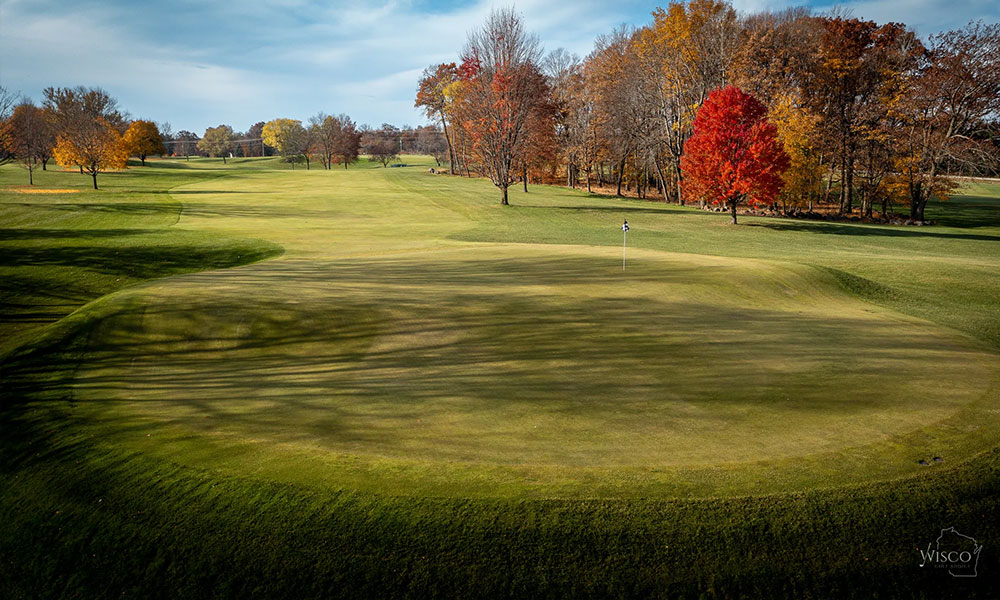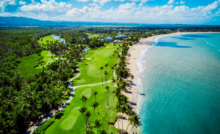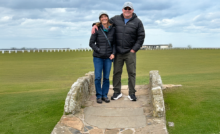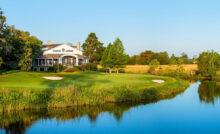West Bend Country Club: The Best Front Nine in Wisconsin


West Bend Country Club
By now, golf enthusiasts across the Midwest have become quite familiar with the names William Langford and Theodore Moreau, but believe it or not that was not always the case.
This stalwart duo of golf course architects, based out of the Chicago area, designed over 200 courses starting in the late 1910’s, with some of their best work here in the Midwest and particularly in Wisconsin including Spring Valley in Salem, the Links course at Lawsonia, Ozaukee Country Club and the front nine at West Bend.
All four of these courses were developed between 1922-1930, with Lawsonia and West Bend being the most recently opened in the Spring/Summer of 1930.
West Bend Country Club
While West Bend has yet to reach the same level of notoriety as the fabled Links course at Lawsonia, it’s an absolute gem that’s been long held in high regard, especially amongst golf enthusiasts in Southeast Wisconsin.
“The best front nine in the Milwaukee area,” is what many who’ve played it will say, and I quite enthusiastically agree. It might even be the best front nine in the state.
Langford & Moreau’s front nine masterpiece is an awe-inspiring trek across stunning, wave-like post-glacial land with some of the best, most wonderfully constructed greens south of Green Lake. It’s got sharp teeth, requiring a bit of length (3,539 yards from the tips) and a lot of precision, not to mention refined short game skills.
When golf course architecture started becoming much more mainstream in the early-to-mid 2010’s, thanks in large part to the efforts and success of Andy Johnson and The Fried Egg, one of the many recipients of that newfound attention was Langford and Moreau.
Related: Summer’s Sunrise Over the Whistling Straits Golf Course
Their designs utilized steam shovel technology during construction to move massive amounts of terrain and create bold, accentuated green complexes. They used dramatic bunkering and mounding throughout their layouts to influence angles of play, conceal site lines and create strategic zones that can propel shots onward using speed slots – or punish overly aggressive ones that miss their marks.
Their courses are fascinating to play and study, and when traversing a layout like the front nine at West Bend it doesn’t take long to come to one conclusion: These guys were geniuses.
The back nine is no slouch in its own right, but it has always stood in contrast to the front.
30 years following the 1930 opening of the front nine (with the Great Depression, war times and an endless proliferation of tree planting separating their debuts), the club hired Midwest architect David Gill to design the back and in the process finalize an 18-hole course.
While there was an undeveloped Langford & Moreau plan available for the second nine, the club decided to go in a different direction and Gill was tasked with developing a new and unrelated routing.
I am sure that if this project was on the docket today that every member of West Bend would be in favor of developing the L&M back nine (and anyone dissenting would likely be burned at the stake), but that was decided against more than 60 years ago and – unless they wipe the slate entirely clean, which is unlikely at best – will not be undone. It has since been the club’s onus to better align the ways out and in – a never-ending quest to present a uniform Golden Age, Langford & Moreau-level golf experience – ever since.
Gill’s was an interesting nine-hole layout on its own, utilizing the extreme contours of the land interestingly and with dramatic flair, but the design has always stood in opposition to the front. It featured more sand traps (not tough to accomplish when the front nine only has eight!), was more parkland in style and overall incorporated a very different playing strategy. It even headed out and returned in opposite directions of Langford & Moreau’s plans, making it virtually impossible to renovate over time into L&M’s proposed routing.
All that to say the club’s only realistic roadmap for developing uniform character across the 18 holes is to thoughtfully renovate the current routing, incorporating key Golden Age design elements while removing those in juxtaposition to the front nine’s style.
Related: Golf Course Review: Pioneer Pointe designed by Lohmann Quitno
It’s in that vein that St. Louis-based architect Kye Goalby was hired to both renovate the back nine and also shepherd an ongoing refinement of the front.
Goalby’s work, beginning with front nine sand bunker renovations on the ninth, eighth and second holes in 2010, is focused on elevating the entire property but specifically L&M’ing (not a word, but it should be) the Gill holes both subtly and not to subtly one by one to create cohesion across the property.
Work on the back nine started in 2012 on 14, a short downhill par four that forced one angle of play toward a fairway left of the pond before heading uphill. Goalby opened this up, removing trees and providing a direct flight path over water to allow for more daring, risk/reward tee shots.
The 10th, 11th, 12th, 13th and 15th holes have also since been addressed, creating more substantial green complexes that are more akin to the ones found on the front nine, removing a number of the sand traps in favor of mounding and grass bunkers, cutting down trees en masse and instituting more architecturally intriguing Golden Age design elements that are elevating the back nine’s pedigree more in line with the front.
There’s more work to do, of course. Holes 16 through 18 were under repair throughout the past season and are scheduled to reopen later in 2023.
When the back nine is already very good, and changes can be made to significantly improve it, I can’t imagine there’s a membership in Wisconsin that would approve a complete redo, and I for one think Goalby, Bonlender, Head Pro Jim Kelly and the club’s leadership are doing a fantastic job with improving what they can. I loved the golf experience at West Bend the first time I played it in 2015, and it is already noticeably better now than it was even then.
West Bend Country Club course
The first hole at West Bend is a straight-away par four teed up from between 400 and 420 yards from the three back tees. The fairway is wide and open, a welcomed site from any first tee box. Where this hole is special, though, and that players can get excited to experience throughout the course, is in its green surrounds. A massive complex that ascends from the fairway (the second most elevated green on property), very little is revealed to players from the fairway.
This is a trend I’ve come to know and appreciate about Langford/Moreau designed courses over the years: The game they play with golfers’ minds to add that little tinge of doubt that where you’re aiming is the right target. In this case, the small bit of green visible from the fairway conceals a fairly large, crowned putting surface that runs off in most directions.
The green on two would be the best green on most golf courses in Wisconsin, but on West Bend’s front nine it’s almost just another green pad. Highly risen with an infinity-like view over the rest of the course on the opposite side of the property’s driveway, the green runs back-right to front-left and requires a really well-struck approach shot.
Because players had started teeing off already, I was unfortunately not able to get an updated photo of the second hole, so I apologize for the use of an old 2015 one from the last time I reviewed West Bend. As you will hopefully agree, my camera skills have improved a little since those days!
To me, the third has the best green complex on the entire course at WBCC. Similar in design to the 12th green at Lawsonia, three has a tremendously deep back-to-front pad that’s stamped near the middle on both sides, causing it to drop 3-4 feet from the putting surface:
A slight left-to-right par five, the third is only a bit over 500 yards from the two back tees but with such a severe green is almost impossible to hit in two, and then really tough to get a recovery shot near because of the putting surface’s extreme internal contours and short lateral dimensions.
This is one of the best greens in the whole state.
The fourth is a long par three that plays 217 from the tips, or 210 from the blue tees. A flat shot from tee to green, the real peril on this hole is with the sheer size (it’s the largest of the enormous greens at WBCC) of and slopes on its putting surface. The pin was back-left during our round and a tremendous challenge to approach – Troy and I both three-putted it.
The entire front nine at West Bend is terrific, but the end of it is exceptional. It’s as good as any stretch of holes in the state, in fact, especially between the par five sixth and par four ninth, but especially the seventh and eighth which are as enthralling a 1-2 punch as any in Wisconsin.
The sixth is a rollercoaster of a par five that tees off to an open, extremely undulating fairway that drops into oblivion at around 275 yards. Similar to the swale in the fairway of the 13th at Lawsonia, it’s a mostly blind shot from there as players need to hit plenty of club but somehow get it high enough in the air to crest the fairway mounding.
While the fairway is unique, the green area is superb with signature Langford/Moreau style incorporated into a tree-backed setting. Front-right mounding gives players a little to think about while, perhaps untraditionally for a Langford and Moreau course, there’s a sliver of green surround that can be used to run shots up and on to the putting surface.
Seven is the kind of golf hole you love to stare at but that creates all kinds of anxiety to play. The tee shot has more room to miss than you’d think when swinging from the tee, but the challenge here comes in on the second shot, and every other swing taken before the ball finally stops on the green… and below the hole.
The approach on seven is to one of the most highly elevated greens I’ve seen in my life, and also one of the smallest and most severely crowned on the property. Between Troy and me (a combined 9-handicap – okay, mostly thanks to Troy being a 1), we finished this hole at I believe seven over par – we had no issues off the tee and were both within five yards of the green on our approaches. Troy then chipped off the green from the backside to the bottom of the hill, and my attempted flop from the right rolled past the hole and down the entire front cliff. The adventure continued when my next recovery shot hit the fringe at the top of the hill and then rolled back past my feet. I love this game.
This is a tough golf hole, but man is it spectacular to gawk at!
To me, the eighth is one of the most well-designed par threes in all of Wisconsin. It is classic Langford and Moreau architecture in a simple-to-see, harder-to-execute fashion teed up from just 138 yards from the blue and gold tees.
With an exemplary back-left to bottom-right canted green complex, the design team used mounding between the tees and green to conceal the entrance and create uncertainty in players’ minds – adding that little bit of doubt around club selection and target line. The only safe target on this green is smack dab in the middle, and even then you’ll be navigating a circuitous putting line to almost any hole location in order to manage par.
The club has done a really nice job thinning this area out over recent years, by the way. This was a very wooded section the last time I was at West Bend, and that was I’m sure detrimental to the health of the green’s turf and surrounds. Clearing out excess greenery now allows the grass to breathe, plus reveals a nice view of the ravine separating the sixth, seventh and eighth holes.
The front nine ends with a fun tee shot out of the woods to a rollicking, wide-open fairway running downhill toward the clubhouse. While the pond doesn’t really come into play off the tee, a long tee shot down the right side can approach it.
With this downhill run, the ninth plays significantly shorter than the 471 (tips/black tees) or 445 yards (blues) suggest on the scorecard, but the toughest challenge on nine is the approach shot to its well-elevated green complex perched above deep traps on either side.
In case you haven’t been keeping track, by the way, these two sand bunkers along with the two that surround the eighth green make up half the traps on the entire front nine.
The back nine heads out opposite of the first hole, uphill and away from the clubhouse. A bit of a handshake to start the second nine, it’s a short par four (340 from the blues and whites) that plays slightly longer because of the change in elevation.
To Goalby’s credit, the green complex on ten feels very much like a traditional Langford/Moreau design – the right side is risen ~ five feet with a depression to carry from that side while the left is bordered by a long trap.
A tough par five, the eleventh does a great job showing off the beautiful property West Bend inhabits. All three shots here need to be accurate, especially the straightaway first to set up any chance at getting on or near the green at the bottom of the steep, ski slope-like hill in two.
With pond right and trees left, the second shot is no picnic, either, as is the third with the hole’s small putting surface, elevated green, bunker short-left and mounding and grassed depressions to the right from what will likely be an awkward stance and ball position.
The twelfth is one of the signature holes on the back nine, featuring a tee shot in a wooded section of the course that plays over water and then veers uphill to the right.
Something about thirteen gets me every time. It’s a par three that’s not overly long – just 172 from the first tees in (190 from the tips), and everything’s in front of you with a decent sized green. It’s at one of the highest points of the course, though, which undoubtedly brings in some wind. In the five or six times I’ve played West Bend, I have still never hit this green off the tee.
With the most highly elevated tee shot on the course, fourteen is a very fun golf hole.
Teeing off from above, the hole’s layout plays downhill to a pond and then back up with two laterally staggered bunkers directly between the tees and green. The smart play, of course, is to the fairway left, but at under 350 yards and with all that elevation to take advantage of it’s hard not to air out driver!
I think the club did a great job on fifteen, the second par five on West Bend’s back nine. In the past five or so years, in an effort to make it a more challenging hole with more Langford & Moreau design influence, they removed a lot of the trees and all the sand from its fairways, instead opting for deep grass bunkers that if hit will force players to consider laying up with a more lofted club selection.
The green was also moved slightly right, and risen significantly. At 527 yards, it’s definitely a reachable par five for longer hitters but will most likely require a shaped left-to-right fade in order to get home in two.
Sixteen, seventeen and eighteen were all being worked on while we visited by golf course architect Kye Goalby. Sixteen, previously one of the course’s toughest holes, was de-treed significantly and reworked especially around the green.
The sand trap left has been taken out in favor of a steep front-left edge, and the hole now plays more like a Redan, accepting approach shots on its right and middle sections.
Nestled along the property’s eastern border, the seventeenth is a short par three that plays over a swale in the hitting zone leading downhill and past a pond on the left. The green is perched into the hillside with a bunker right and “WBCC” now displayed in decorative rock overlooking the putting surface.
Eighteen has always been a tough finish at West Bend, and a great four with two well-placed shots. Well over 400 yards (422 from the blues), it plays out of the tree line to a right-to-left dogleg then between two ponds that lead home toward the clubhouse.
Like on sixteen, the sand traps on the finishing hole have been replaced with grass bunkers, allowing shots to run off its edges and lead to tough recoveries. The removal of sand, though, means players are no longer hitting sand shots directly toward the water and I believe is more in line with what Langford & Moreau might have designed.
Already one of the state’s best golf courses, West Bend is only getting better
West Bend is one of the top private golf clubs in Wisconsin, and one of the very best tracks in the Milwaukee area. There are no doubts about that.
It is a course with great history and one of the best contiguous nine-hole stretches in the state – up there with Blackwolf Run’s back nine on the Meadow Valleys and the back nine at Milwaukee Country Club.
Having designed hundreds of courses throughout their career, Langford and Moreau were obviously well thought of during their time and saw plenty of success. It’s hard for me to believe, though, that it matched the posthumous raving their work receives now.
The Links course at Lawsonia, for example, has moved up to #23 on GolfWeek’s list of the country’s Top 100 Courses You Can Play since its bold 2014 Craig Haltom-led “restovation” project. While the national “lists” are considerably harder to breach for private clubs, West Bend’s front nine has a similar look and feel, and even has better land. It is world-class.
The thoughtful redesign work on the back nine being carried out by Goalby and Bonlender will only help elevate the course’s position among the elite clubs in the area, and its always stellar conditions make it one of those golf courses that, if given the opportunity to visit, every golf enthusiast and admirer of Golden Age architecture should take advantage of.
“We can have all the ideas in the world, but at the end of the day if the membership isn’t behind it then it doesn’t get done. We’ve been fortunate to have our Board, Committee, and membership behind us the whole way, helping always push projects forward and take the next steps to allow us to make this Langford & Moreau Golden Age golf course shine.”
Brian Bonlender, Golf Course Superintendent at West Bend Country Club
All images are Copyright WISCOGOLFADDICT
Recent Posts
Discover Puerto Rico for Great Golf Trips and After-Round Activities, Amenities
Golfers cannot live by the game alone which is why Puerto Rico provides the perfect…
Q&A with a Multi-talented Golf Course Architect – Part 2: Making the Rounds – Installment 39
This column features recollections of the author’s 37 years as a golf writer. These installments…
With LOKSAND, Bunker Faces & Edges ‘Aren’t Going Anywhere’
LOKSAND Global has announced North American availability of the stabilization product LOKSAND (www.loksand.com), in addition…
One of the Biggest Jobs in Golf
When Rory McIlroy finally slipped into the Green Jacket on Sunday, April 13, 2025, after…
Audubon International Marks Earth Day In Growth Mode
As the world celebrates Earth Day on April 22, Audubon International – the environmentally focused non-profit…
Help keep golf sustainable by bidding in GCSAA’s Rounds 4 Research online auction
In celebration of Earth Day, you can help fund the research that advances golf’s environmental…


